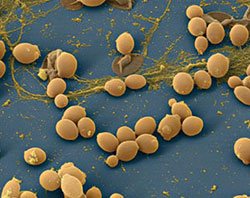Vaginal Yeast Infections

Yeast is an organism that normally lives in the vaginal mucosa in small quantities. Vaginal yeast infection occurs when the number of fungal yeast cells that grow in the vagina increases. At least 75% of women experience at least one episode of vaginal yeast infection in their lifetime. Although it is an infection that causes considerable discomfort, it is not serious and is easily treatable. About 80-90% of vaginal yeast infections are caused by the species Candida Albicans.
The development of the infection is favored in situations where the vaginal PH drops below 5. A healthy vaginal mucosa has a considerable amount of bacteria and a few yeast cells. The most numerous bacterium in the vagina is called Lactobacillus acidophilus. It helps in keeping other organisms such as yeast under control. When something that changes the balance of this important organism occurs, yeast can grow quickly and cause the symptoms of a yeast infection. It is not a sexually transmitted infection. This imbalance is caused by many factors such as:
- Use of antibiotics
- High levels of estrogen hormones that commonly occur during pregnancy, when using certain types of oral contraceptives.
- Diabetes
- HIV
- Use of corticosteroids.
- Obesity
- Chronic diseases that affect immune system disorders.
The main symptoms of vaginal yeast infection are:
- Burning sensation in the vagina and on the external genital organs.
- Itching and redness.
- Burning or pain during urination.
- Burning or pain during sexual intercourse.
- Thick, increased, odorless white vaginal discharge.
These symptoms in most cases increase a week before the menstrual cycle. If more than four episodes of yeast infection occur in a year in a patient, then it is called chronic yeast infection. By carefully evaluating these signs, a woman can easily understand when she has a yeast infection, for which she should consult a specialist obstetrician-gynecologist especially if she is pregnant. Often women who suffer from chronic yeast infection self-medicate based on the experience they have already formed in recognizing the signs and treating them.
The advice given for the prevention of vaginal yeast infections are:
- Care for intimate hygiene.
- After personal needs, it is advised to wipe from front to back to avoid spreading the yeast from the anus to the vagina or urinary tract.
- Use of hygienic cotton underwear.
- Avoiding tight clothing especially trousers.
- Changing the bathing suit immediately because wearing a wet suit for a long time increases the temperature and moisture in the genital area predisposing the development of yeast.
- Changing sanitary pads or tampons frequently.
- Avoiding the use of sprays, perfumes, or deodorants in the genital area.
Your obstetrician-gynecologist can diagnose vaginal yeast infection through:
- The symptoms described by you combined with a simple gynecological visit.
- Simple vaginal swab
- Culture of vaginal secretions
- Simple blood analysis or biochemical analyses as well as urine analysis.
Treatment of yeast infections:
- Local antifungal in the form of cream and suppositories for 1, 3, or more days depending on the concentration of the medication and the severity of the infection.
- Oral antifungals (by mouth).
- Boric acid vaginal capsules (only on prescription and not if the patient is pregnant).
- In chronic yeast infections, treatments are prolonged and repeated from time to time.
Very accurate article that helps the community. Thank you!
Sent by Andora kule, më 24 February 2017 në 15:22
Thank you Andora!
Replay from Dr. Jonida Reveli, më 24 February 2017 në 15:24